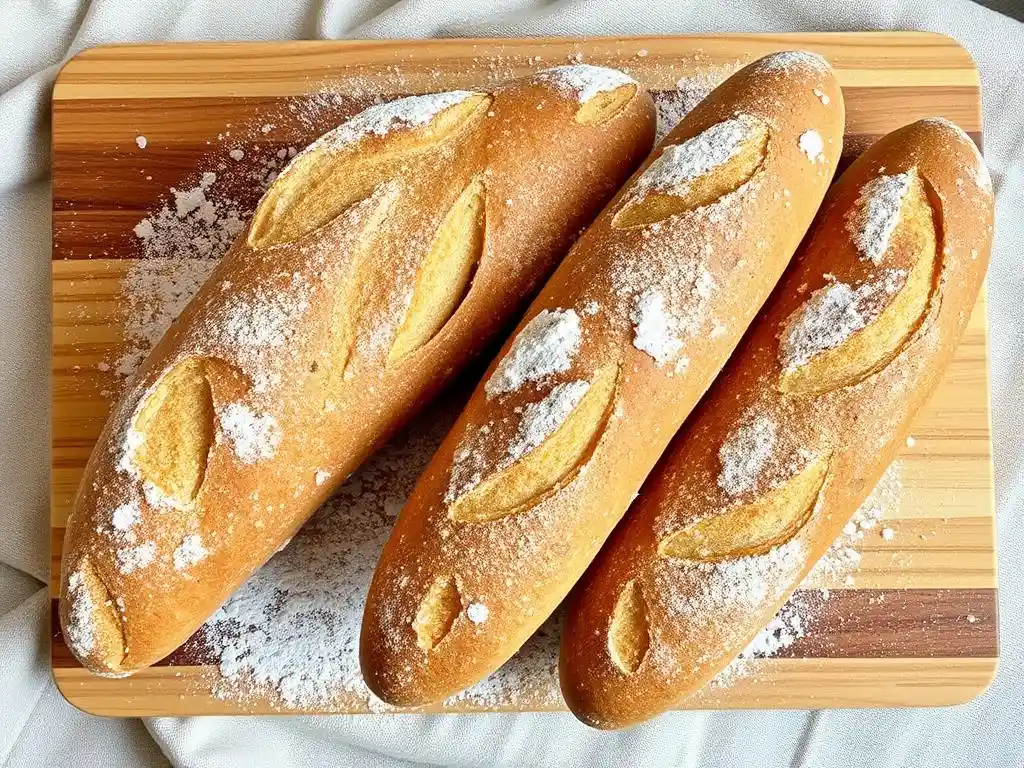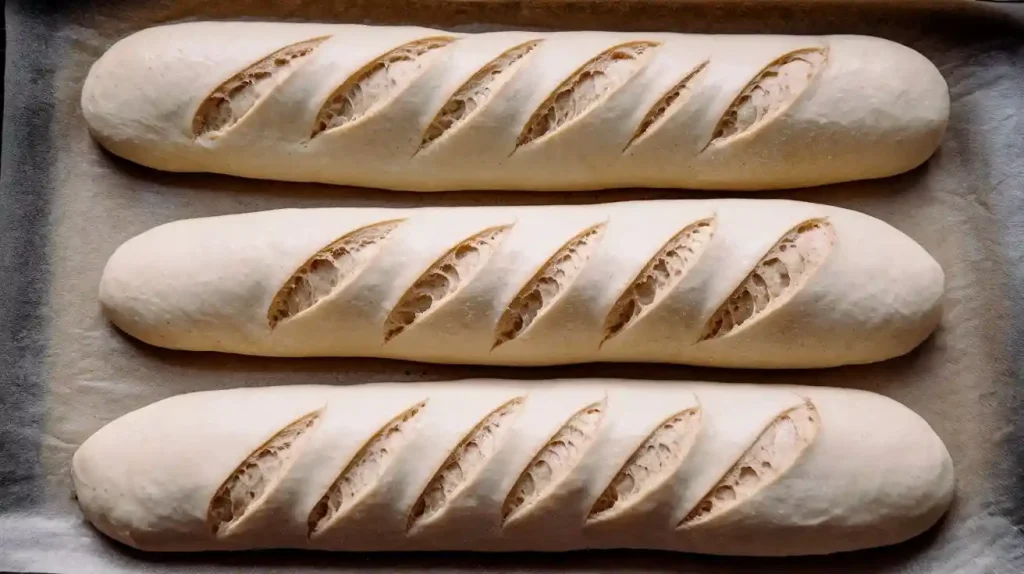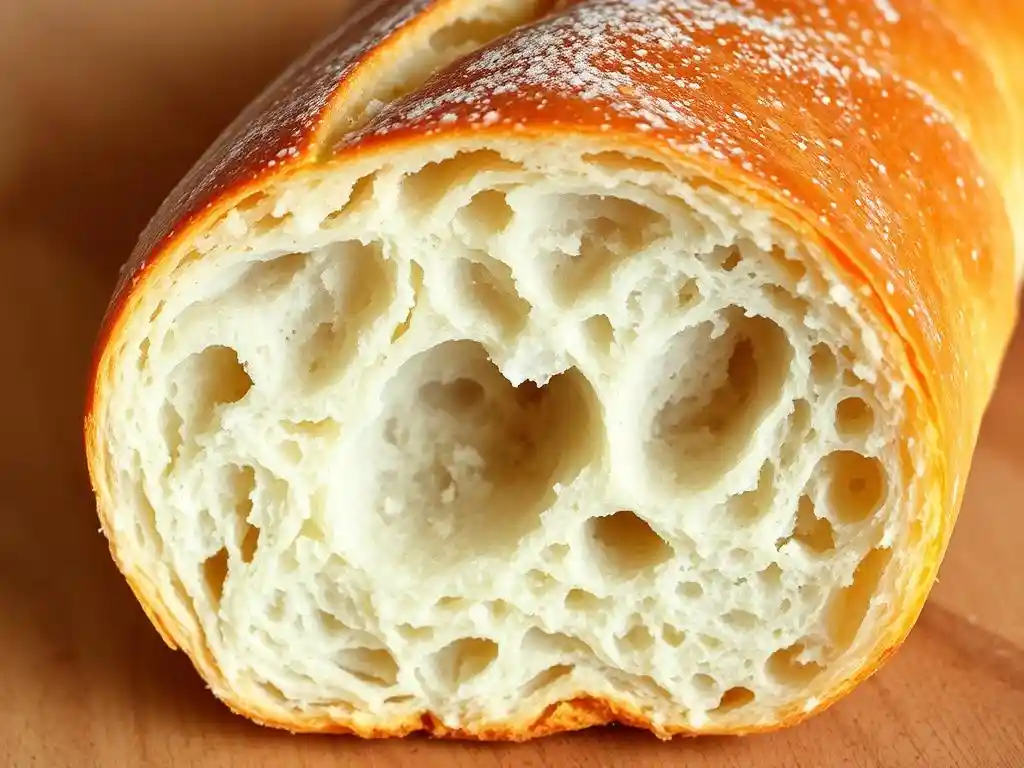The French baguette is one of the most recognizable bread types in the world. Traditionally, it measures around 65 cm (approx. 25.6 inches) in length, with a thin, crisp crust and a soft, chewy crumb. Baguettes can vary in their flavor, texture, and appearance depending on the ingredients and techniques used, but the basics remain the same: high-quality flour, water, yeast, and salt.
To perfect a French baguette, you’ll need a deep understanding of technique, time, and temperature—all of which influence the dough’s rise, texture, and flavor.
Table of Contents
- What Is a French Baguette?
- Baguette Classique vs. Baguette Tradition
- Key Ingredients for a Perfect French Baguette
- Step-by-Step Baguette Recipe
- Essential Techniques for the Perfect Baguette
- FAQs: Baguette Troubleshooting
- Conclusion: Crafting the Perfect French Baguette
What Is a French Baguette?
The French baguette is one of the most recognizable bread types in the world. Traditionally, it measures around 65 cm (25.6 inches) in length, with a thin, crisp crust and a soft, chewy crumb. Baguettes can vary in their flavor, texture, and appearance depending on the ingredients and techniques used, but the basics remain the same: high-quality flour, water, yeast, and salt.
To perfect a French baguette, you’ll need a keen understanding of technique, time, and temperature—all of which influence the dough’s rise, texture, and flavor.
Baguette Classique vs. Baguette Tradition
Before diving into the recipe, it’s crucial to distinguish between two types of baguettes you’ll often find in France: the Baguette Classique and the Baguette Tradition.
Baguette Classique:
- Mass-produced: Typically made in larger quantities and baked quickly to meet demand, especially in busy bakeries or supermarkets.
- Baker’s yeast: The fermentation process is faster as these baguettes use baker’s yeast, typically in the form of instant or fresh yeast.
- Additives: In some cases, a Baguette Classique might contain additives such as ascorbic acid or malt powder to enhance texture, flavor, and shelf life.
- Result: While still enjoyable, a Baguette Classique often lacks the depth of flavor and rustic appearance of a more artisanal loaf.
Baguette Tradition:
- Strict guidelines: By French law, a Baguette Tradition must be made with only four ingredients: flour, water, salt, and leavening (usually sourdough or baker’s yeast). No additives or preservatives are allowed.
- Long fermentation: The dough undergoes a slower fermentation process, often using sourdough or a poolish (a type of pre-ferment), which contributes to a more complex flavor.
- Crust and Crumb: Expect a crispier crust and a more open crumb with larger air pockets compared to a Baguette Classique.
- Result: The flavor is more robust, with a slight tang from the natural fermentation process.

Both styles have their place in French cuisine, but for professional bakers aiming for an authentic, artisan touch, the Baguette Tradition offers the most rewarding results.
Key Ingredients for a Perfect French Baguette
To create an authentic French baguette, whether it’s a Classique or a Tradition, you’ll need the following:
- Flour: A high-protein, unbleached flour is essential for good gluten development. Look for flour labeled “Type 55” or “Type 65” for French-style baguettes. If you can’t find these, bread flour works well.
- Water: Use filtered water for better dough consistency.
- Salt: Sea salt or kosher salt helps to strengthen the gluten and enhance the flavor.
- Yeast: Depending on the style, you’ll use either baker’s yeast or sourdough starter. Learn more about yeast types here.
Step-by-Step Baguette Recipe
Preparing the Dough
- Ingredients:
- 500g bread flour (or Type 55/65 flour)
- 350g water (cold)
- 10g sea salt
- 2g instant yeast (or sourdough starter for a Tradition baguette)
- Mixing: In a large bowl, combine the flour and yeast (if using baker’s yeast). Add the water and salt, mixing with a dough hook or by hand until the dough comes together. It will be sticky, but resist the urge to add more flour.
- Autolyse: Let the dough rest for 20–30 minutes before kneading. This resting period allows the flour to hydrate, making kneading easier and improving gluten development.
- Kneading: Knead the dough for about 10 minutes until it becomes smooth and elastic. If you’re using a sourdough starter, fold the dough every 30 minutes during the first 2 hours of fermentation instead of traditional kneading.
- First Rise: Cover the dough and let it rise at room temperature for 1.5 to 2 hours or until doubled in size.
Shaping the Baguettes
- Pre-shaping: Gently deflate the dough and divide it into 3 equal portions (around 250g each).
- Shape the loaves: Form each portion into a loose ball, then let them rest for 15 minutes. Roll each ball into a long baguette shape, being careful not to deflate the dough.
- Final rise: Place the shaped baguettes on a lightly floured couche (a linen cloth designed for bread shaping) or parchment paper. Let them rise for another 45 minutes.
Scoring and Baking the Loaves
- Preheat the oven: Set your oven to 475°F (245°C). Place a baking stone or steel in the oven to preheat, and prepare a tray with water to create steam.
- Scoring: Right before placing the loaves in the oven, use a sharp blade to make 3–4 diagonal cuts on the surface of each baguette. Scoring helps control how the loaf expands in the oven and creates the signature look of a baguette.
- Baking: Transfer the baguettes onto the hot baking stone. Pour water into the steam tray and close the oven door quickly. Bake for 20–25 minutes or until the baguettes are golden brown with a crispy crust.
- Cooling: Remove the baguettes from the oven and let them cool completely on a wire rack before slicing.

Essential Techniques for the Perfect Baguette
Hydration and Gluten Development
Hydration levels in baguette dough are crucial to achieving the ideal crumb structure. A higher hydration dough (around 70–75%) will result in an open crumb with larger air pockets, which is essential for a Baguette Tradition. To manage a high hydration dough, consider using the stretch-and-fold technique during fermentation instead of traditional kneading.
The Science of Fermentation
Long, slow fermentation is key to developing flavor. Whether using baker’s yeast for a Baguette Classique or a sourdough starter for a Baguette Tradition, allowing the dough to ferment slowly at a cooler temperature brings out deeper, more nuanced flavors.
For more on working with sourdough in bread recipes, check out this guide on sourdough sandwich bread.
Achieving the Perfect Crust
The hallmark of a great baguette is its crust—crisp, golden, and full of flavor. To achieve this:
- Steam: Steam is essential for the first part of the baking process. It helps the crust set slowly, allowing for maximum expansion.
- Baking Stone: A hot surface like a baking stone or steel helps to create an even, golden crust by distributing heat evenly.
- Scoring: Proper scoring ensures the baguette expands without bursting unpredictably.
For more insight on oven temperatures and baking techniques, refer to this guide From KingArthur.

FAQs: Baguette Troubleshooting
- Why is my baguette flat?
Flat baguettes can be caused by underproofing or overproofing. Make sure your dough has doubled in size but hasn’t deflated before shaping. - Why is the crumb of my baguette too dense?
A dense crumb usually results from under-kneading or using too little water. Ensure your dough is well-hydrated and properly developed through kneading or folding. - How do I prevent my baguette crust from becoming too hard?
If the crust is too thick or hard, you may be overbaking or lacking steam during the first part of the bake. Introduce steam in the first 10 minutes of baking.
Conclusion: Crafting the Perfect French Baguette
Mastering the French baguette requires practice, patience, and attention to detail. By understanding the differences between the Baguette Classique and Baguette Tradition, and using the right techniques, you’ll be well on your way to baking baguettes that rival those found in the best French boulangeries.
Whether you prefer the speed and ease of a Classique or the depth of flavor and texture found in a Tradition, following the tips and techniques in this guide will ensure your baguettes come out perfectly every time.

